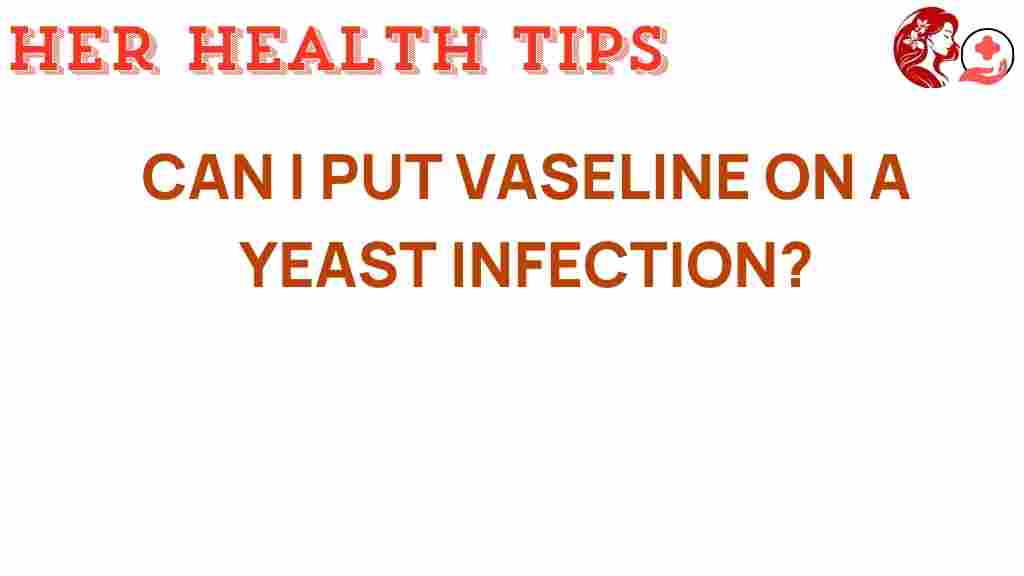The Surprising Truth: Can Vaseline Help Relieve a Yeast Infection?
Yeast infections are a common health issue, affecting millions of individuals each year. While there are well-known treatments available, many people are seeking alternative methods for relief. One such method that has garnered attention is the use of Vaseline. In this article, we will explore the potential role of Vaseline in the treatment of yeast infections, examining its properties, benefits, and any precautions that should be taken.
What is a Yeast Infection?
A yeast infection, typically caused by an overgrowth of the fungus Candida, can lead to uncomfortable symptoms such as:
- Itching and irritation in the vaginal area
- Unusual discharge that is often thick and white
- Burning sensation during urination
- Discomfort during sexual intercourse
While yeast infections can occur in various parts of the body, they are most commonly associated with the vaginal area in women. Understanding the symptoms and causes is crucial for effective treatment.
Understanding Vaseline
Vaseline, a brand of petroleum jelly, is often used for its moisturizing properties. It acts as a protective skin barrier, sealing in moisture and preventing dryness. While it is not an antifungal treatment, its soothing properties can provide comfort in certain situations.
Can Vaseline Help with Yeast Infection Treatment?
When considering the use of Vaseline for yeast infections, it’s essential to understand its role:
- Moisturizing: Vaseline can help keep the skin moisturized, which is beneficial if the skin is irritated due to a yeast infection.
- Skin Barrier: It forms a protective layer over the skin, which may aid in preventing further irritation.
- Soothing: The application of Vaseline can provide immediate relief from discomfort and itching.
However, it is important to note that Vaseline does not treat the underlying infection. It should not be considered a substitute for antifungal treatments prescribed by a healthcare professional.
Step-by-Step Process: Using Vaseline for Yeast Infection Relief
If you decide to use Vaseline as a soothing agent during a yeast infection, follow these steps:
- Consult a Healthcare Professional: Before trying any home remedies, it’s important to consult with your doctor, especially if you are experiencing severe symptoms.
- Ensure Cleanliness: Wash the affected area gently with mild soap and water. Pat dry with a clean towel.
- Apply Vaseline: Use a clean finger or cotton swab to apply a thin layer of Vaseline to the irritated area.
- Reapply as Needed: You can reapply Vaseline throughout the day as needed for relief from itching and irritation.
Complementary Home Remedies for Yeast Infection
While Vaseline may provide temporary relief, it’s also beneficial to explore other home remedies that can support treatment:
- Probiotics: Incorporating probiotics into your diet can help restore the natural balance of bacteria in the body.
- Coconut Oil: Known for its antifungal properties, coconut oil can be applied topically to combat yeast growth.
- Apple Cider Vinegar: Diluted apple cider vinegar can be used in baths or as a rinse to help restore pH balance.
- Garlic: Garlic has natural antifungal properties and can be consumed or applied topically (ensure it’s properly prepared first).
For more information on natural remedies, check out this informative resource.
Troubleshooting: When to Seek Professional Help
While many yeast infections can be managed with home remedies, there are certain situations where it is critical to seek professional medical advice:
- If symptoms persist for more than a few days without improvement.
- If you experience severe pain, fever, or a strong odor accompanying the discharge.
- If you have recurrent yeast infections (more than four a year).
- If you are unsure whether your symptoms are due to a yeast infection or another condition.
Conclusion
In conclusion, Vaseline may offer temporary relief for the discomfort associated with yeast infections due to its moisturizing and soothing properties. However, it is not a treatment for the infection itself. Always consult with a healthcare professional before trying any new treatments or home remedies. For effective yeast infection treatment, antifungal medications are often necessary. By combining the use of Vaseline with other home remedies and proper medical guidance, you can find a comprehensive approach to managing yeast infections.
Remember, your health is important, and taking the right steps toward treatment can make all the difference in finding relief.
This article is in the category Conditions and created by HerHealthTips Team
